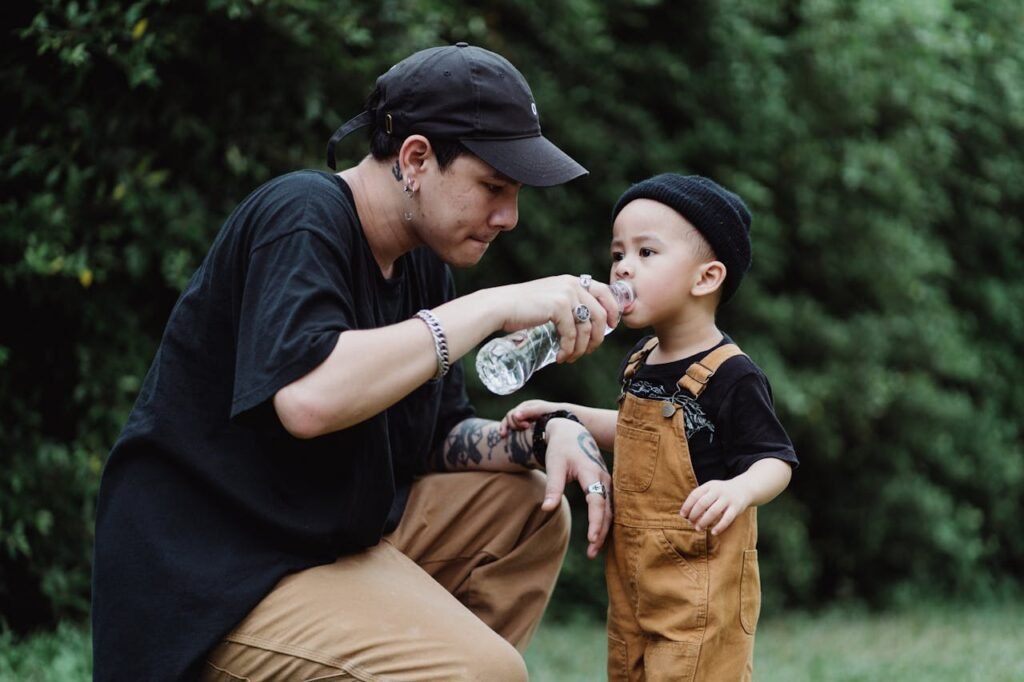Water is the most fundamental building block of a healthy body, yet getting children to drink enough of it often feels like a daily battle. For many parents, encouraging hydration can seem like a tedious chore—especially when sugary juices or carbonated drinks are competing for attention. But pediatricians know that hydration isn’t just about quenching thirst. It’s about supporting mood, focus, digestion, immunity, and overall development.
In this pediatrician-backed guide, you’ll discover why water matters so much for children and exactly how to make hydration a fun, non-negotiable part of their daily lives. This isn’t general information—it’s a practical, emotionally intelligent, and science-informed strategy designed to help your child thrive with every sip.
Why Pediatricians Prioritize Hydration in Children
Children are more vulnerable to dehydration than adults. Their smaller bodies, higher activity levels, and underdeveloped thirst signals make them especially prone to fluid imbalances. Pediatricians understand that even mild dehydration can affect a child’s mood, attention span, and energy levels. In fact, many of the behavioral issues reported in clinics—such as irritability, headaches, or difficulty concentrating—are directly related to insufficient water intake.
But the concern goes deeper. Pediatricians are trained to identify how chronic low hydration can lead to constipation, poor appetite, overheating, and an increased risk of urinary tract infections. For kids with certain medical conditions or sensory processing differences, hydration isn’t just important—it’s critical.
How Much Water Do Kids Really Need?
Rather than relying on one-size-fits-all charts, pediatricians assess water needs based on a child’s age, size, activity level, and climate exposure. However, a few basic principles help guide healthy hydration:
-
Ages 1–3: About 4 cups (32 ounces) of fluids per day, including water and milk
-
Ages 4–8: Around 5 cups (40 ounces) of fluids
-
Ages 9 and up: 7–8 cups (56–64 ounces) or more, especially with physical activity
Of course, when children are outdoors in warm weather, sick with fever or diarrhea, or engaged in sports, these needs can significantly increase. Pediatricians urge parents to focus on consistency rather than waiting for signs of thirst, since kids don’t always recognize or express dehydration until it’s advanced.

To understand how hydration interacts with seasonal shifts, take a look at how seasonal mood swings affect children—especially in hot weather when fluid loss escalates.
Warning Signs Pediatricians Watch for in Dehydrated Children
Unlike adults, children don’t always communicate discomfort clearly. Pediatricians are trained to identify subtle signs of dehydration, which may include:
-
Dry lips and mouth
-
Sunken eyes or dark under-eye circles
-
Headaches or dizziness
-
Irritability or unexplained crying
-
Reduced urine output or dark yellow urine
-
Fatigue or listlessness
-
Poor concentration or memory lapses
If a child is consistently showing any of these signs—especially when paired with hot weather, illness, or increased activity—it’s time to boost water intake immediately and consult a pediatrician for personalized support.
How to Get Kids Excited About Drinking Water: Pediatrician-Endorsed Tips
Many parents struggle to make plain water appealing, especially when children have developed a preference for sweetened beverages. But pediatricians have seen time and again that turning hydration into a positive, interactive experience changes the game. Here are strategies pediatricians trust to make water fun, consistent, and enjoyable.
1. Turn Water into a Game
Pediatricians encourage making hydration a part of playtime. Children are more likely to stay hydrated when it’s tied to something enjoyable:
-
Sticker charts: Track every glass of water with fun stickers and offer non-food rewards for reaching daily goals.
-
Name the bottle: Let your child decorate their water bottle and give it a silly name or “personality.”
-
Hydration challenges: See who can take the most water sips during a 10-minute timer.
These playful tools teach children to self-monitor fluid intake while removing the battle from the equation.
2. Use Colourful Cups and Straws
Something as simple as a neon straw or a cup with their favourite character can make water feel like a treat instead of a task. Pediatricians note that sensory stimulation—like bright colours and cool textures—can have a positive effect on children who are resistant to change.
Offering a variety of cups, shapes, or novelty straws keeps water feeling “new” and engaging without resorting to added flavours or sugar.
3. Infuse Water Naturally (But Wisely)
Pediatricians approve of naturally flavoured water when done safely and sparingly. Add-ins like:
-
Cucumber and mint
-
Strawberry slices
-
Lemon or orange wedges
-
Watermelon chunks
-
Blueberries or raspberries
…can enhance visual appeal and taste without overpowering the natural benefits of water. Just be sure to avoid artificial flavours or sweeteners, which pediatricians caution against—especially for children under age 5.
4. Lead by Example
Children mimic adult behaviour. Pediatricians often advise parents to make a habit of drinking water visibly throughout the day. Say things like, “I’m thirsty—I need water!” or “I feel better after a big glass of water!” to reinforce positive associations.
Parents who model hydration as a healthy, automatic behavior are more likely to raise kids who view water as their go-to beverage.
5. Make Water a Morning and Bedtime Ritual
Creating hydration rituals around key transition points in the day—like morning wake-up or bedtime wind-down—builds routine into water intake. Pediatricians often recommend:
-
A few sips upon waking to help jumpstart digestion and cognitive clarity
-
A few sips before bed to hydrate gently without overfilling the bladder
Pairing water with toothbrushing, reading, or hugs can create a natural flow that becomes part of your child’s emotional comfort zone.
Pediatric Advice for Different Age Groups
Hydration needs and strategies vary based on a child’s developmental stage. Here’s how pediatricians approach hydration through the early years.
Toddlers (Ages 1–3)
At this age, water introduction should be gradual but consistent. Pediatricians suggest offering small sips of water throughout the day, using open or straw cups (not bottles or sippy cups) to encourage oral development and reduce dependency on sugary liquids.
Pro tip from pediatricians: Offer water before snacks or meals to reduce juice cravings and set a foundation for healthy habits.
Preschoolers (Ages 4–5)
These children respond well to autonomy. Letting them choose their cup or pour their own water (with supervision) boosts confidence and interest.
Pediatricians encourage parents to use hydration-based stories or songs that make water feel like a magical health potion rather than an obligation.
Elementary School Kids (Ages 6–10)
This is when many children fall into habits influenced by peers and marketing. Pediatricians often see an uptick in soda and sports drink consumption during this age—especially during sports or school events.
Reinforce water’s role in brain power and athletic strength. Pediatricians suggest keeping refillable bottles in backpacks and lunchboxes and setting a goal of drinking water at every school break.
Tweens and Teens (Ages 11+)
Older children face increased demands—academically, socially, and physically. Pediatricians see a strong connection between hydration and focus, mood swings, and hormonal regulation in this age group.
When peer pressure pushes kids toward caffeine or sugar-loaded beverages, remind them of how water directly impacts skin clarity, sleep quality, and energy. Pediatricians recommend framing water as a secret advantage for school success and physical performance.
For more on how hydration connects to mood and emotional regulation, explore our full blog on seasonal mood swings in children.
Digital Distraction and Hydration: What Pediatricians Know

Children often skip hydration when screen time takes over. Pediatricians emphasize that hours in front of tablets, TVs, or gaming consoles can cause children to ignore thirst cues completely. This is especially true in warmer seasons, when children may already be at a higher risk of fluid loss.
Create screen time rules that include scheduled water breaks. You can also make hydration part of the screen activity—such as taking a water break before each new game or episode.
If digital safety is a concern in your household, our guide to keeping kids safe online includes additional advice from pediatricians on balancing health and screen use.
Hydration and Sleep: The Connection Pediatricians Emphasize
Many parents worry that drinking water before bed will lead to accidents or sleep disruption, but pediatricians clarify that proper hydration throughout the day reduces excessive nighttime drinking—and potential bedwetting.
Dehydrated children may wake at night with headaches, dry mouths, or irritability. Ensuring balanced fluid intake from morning to dinnertime helps prepare the body for restful sleep.
A well-hydrated child is more likely to fall asleep easily, sleep deeply, and wake up refreshed—a fact pediatricians consider essential to both mental and physical development.
Why Pediatricians See Water as Non-Negotiable
Water isn’t a suggestion—it’s a requirement. From preventing illness to boosting cognitive performance, pediatricians view water as one of the simplest, most effective tools parents can use to support a child’s lifelong health.
By making water appealing, routine, and emotionally positive, families can build habits that reduce the risk of chronic conditions and empower kids to take ownership of their well-being. Pediatricians don’t just want your child to drink water—they want your child to understand its value and feel proud for choosing it.
When hydration becomes a normal, celebrated part of life, you’re not just filling a bottle—you’re building resilience.
